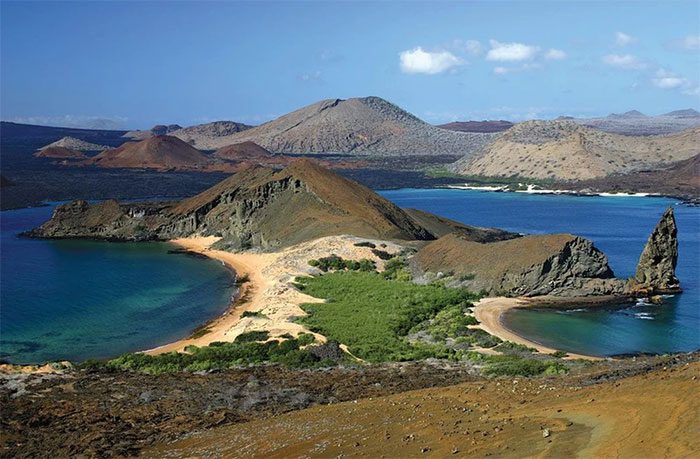As the Earth warms, a region of the ocean off the western coast of the Galápagos Islands has cooled by approximately 0.5 degrees Celsius, making it a fertile ground for various marine species.
A Sanctuary for Marine Life
The Galápagos Islands are renowned for their biodiversity. They are home to a complex ecosystem with a fascinating geological history and unique flora and fauna. Located at the intersection of three major ocean currents—the Humboldt (or Peru Current), Panama Current, and Cromwell Current—these cold currents create a dry, temperate climate for the Galápagos Islands.
Moreover, while most oceans are warming due to climate change, the waters off the western coast of the Galápagos remain cold and nutrient-rich. This fertile area supports phytoplankton and invigorates the archipelago.
Judith Denkinger, a marine ecologist at the San Francisco de Quito University, stated: “The cool waters help sustain populations of penguins, marine iguanas, sea lions, fur seals, and other marine mammals. Many of these species cannot withstand the heat when they are near the equator year-round.”
Over the past four decades, this cold water has cooled by about 0.5 degrees Celsius. This temperature drop raises questions among scientists about how long it will last. Could this offshore area become a refuge for marine animals seeking cooler environments in a warming world? The answer is yes, at least for a while.
There are several other cold water regions on the planet. One is located in the North Atlantic, just south of Greenland, caused by the weakening of global heat-carrying currents.
However, according to new research by climate scientists Kris Karnauskas and Donata Giglio from the University of Colorado, published in the journal PLOS Climate, the cold water in the Galápagos Islands is a product of the island’s topography. Therefore, it is unlikely to be significantly affected by rising greenhouse gas levels and climate change.
The cooling of the waters around the Galápagos Islands is due to upwelling caused by direct vertical compensation. Water from the depths rises to fill the void left by surface water being transported elsewhere along the coast.
By analyzing 22 years of ocean thermodynamic data collected by the Argo float system, along with satellite observations and research vessels, scientists have constructed temperature profiles around several equatorial islands and accurately identified the location of the Equatorial Undercurrent. This is a cold, fast current located about 100 meters below the surface of the Pacific Ocean (abbreviated as EUC).
The EUC is fixed along the equator, caused by the Coriolis effect, an inertial force due to the Earth’s rotation. This effect creates counterclockwise eddies in the Northern Hemisphere and clockwise in the Southern Hemisphere, generating strong upwelling centers.
According to the research by Karnauskas and Giglio, when the EUC is within 100 km west of the Galápagos Islands, it suddenly intensifies as it rises due to the islands.
This results in the water in this region being more than 1 degree Celsius colder than the surrounding waters. The researchers also found a similar but weaker signal in the western Gilbert Islands, located in the western Pacific.

The Galápagos Islands are renowned for their biodiversity.
Restoring Marine Ecosystems
In a separate study, scientist Karnauskas discovered that over the past few decades, the EUC has become stronger and deeper. It has also shifted approximately 10 km south, aligning its path with the location of the Galápagos Islands. All these changes contribute to the cooling of the marine area observed by scientists.
The upwelling and the chemical reactions of photosynthesis create a stable, cooler environment for coral reefs, as well as marine animals and birds living near the poles. This area also provides abundant food sources for marine life.
Jon Witman, a marine ecologist at Brown University who was not involved in the study, remarked that for the marine ecosystem in Galápagos, this cooling process is “somewhat complex.”
“The cold water of the EUC certainly has positive, significant impacts on Galápagos. However, when combined with other phenomena, such as La Niña, temperatures can shock some wildlife, even leading to death,” Witman analyzed.
In the near future, this cold “shield” could benefit life around the Galápagos Islands and other equatorial islands. Scientists predict that this cooling trend is unlikely to last throughout the century. If oceans continue to warm, there will eventually come a time when these waters are overwhelmed.
However, if some species are protected in the Galápagos Islands in the near future, this area could become a “gene bank” and be used to restore devastated marine ecosystems in other regions of the Earth.
“So far, the Galápagos Islands have been very little affected by climate change, making them a potential site for humanity to undertake efforts to mitigate the impacts of climate change,” said scientist Karnauskas.

















































